I Live in a Van, and I Swear By the Jackery Generator
Updated: Feb. 20, 2024
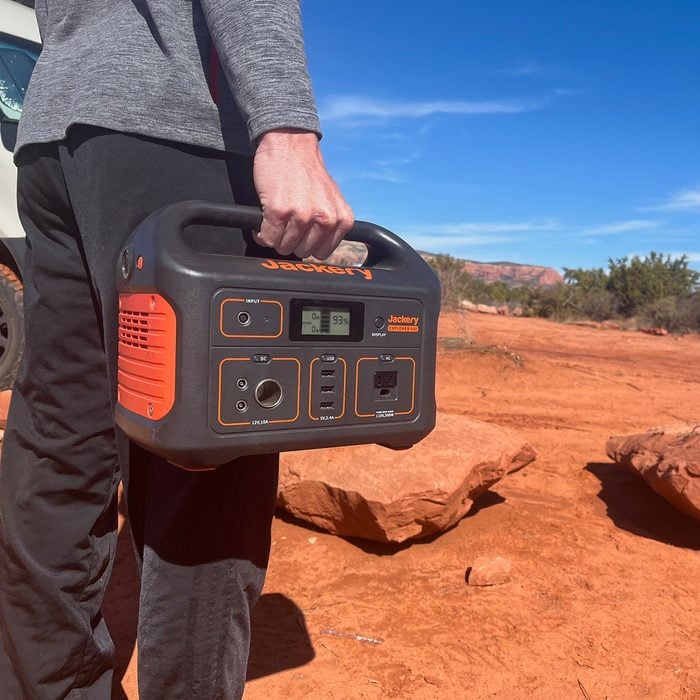
Outdoor enthusiasts will love this 500-watt portable power station that extends the life of their appliances on short trips.
Our editors and experts handpick every product we feature. We may earn a commission from your purchases.
Living on the road, electricity is a commodity. Charging your devices and running essential appliances like a refrigerator isn’t as simple as plugging cords into an outlet. Well, it is, and it isn’t: My van is indeed equipped with standard 120-volt household outlets, as well as USB ports and 12-volt outlets. However, the integrated 320-Ah battery in my campervan has limitations, and I must be wary of power usage in a way I didn’t have to be when living in an apartment, house or condo.
Thankfully, there are plenty of portable power station options that can help extend the life of a van battery, one being the Jackery Explorer 500W Portable Power Station, which I own and have used since 2022.
This handy portable generator was my only source of electricity during a 12-week car camping trip across the U.S. in 2022 (when the engine wasn’t running, of course). I’ve used it as a power source during weather-related outages when living in a traditional home, and I now use the Jackery 500 as a supplement to the stock electrical system in my Winnebago Revel.
In my Jackery generator review, I detail the ins and outs of this portable power station and describe its features and limitations. By the end, you’ll know if this is the right portable generator for you.
What is the Jackery Generator?
Jackery is a well-known brand among outdoor enthusiasts for its portable battery generators and portable solar panels. The brand manufactures a range of portable power setups, from tiny 250-watt portable chargers to ultra-powerful 3000-watt power stations.
This Jackery generator, in particular, is a lower-range model in the company’s lineup, but it’s capable of continuously outputting 500 watts, with 1000-watt surge capabilities. Plus, it supports multi-appliance charging and is lightweight and portable, making it a great all-rounder for outdoor recreationalists.
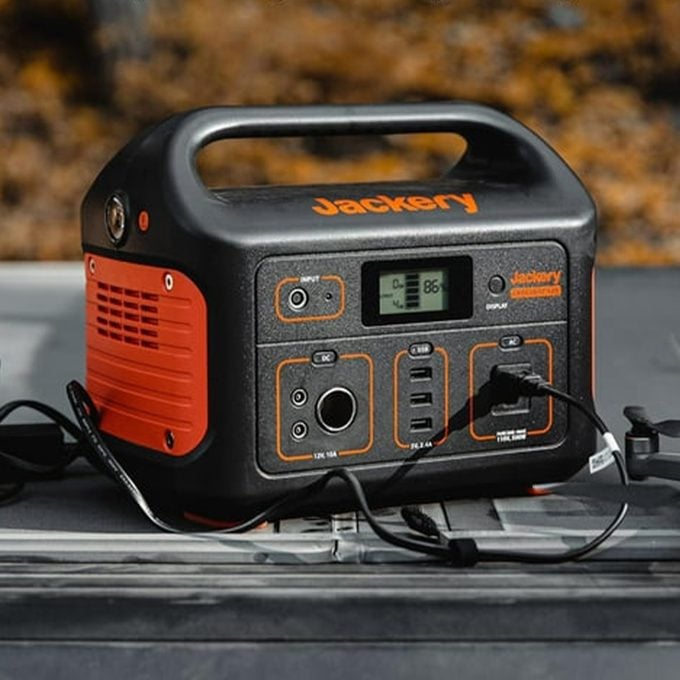 VIA MERCHANT
VIA MERCHANT
We Tried It
Jackery Explorer 500
The Jackery Explorer 500 Portable Power Station charges low to high-power appliances for long hours. It's ideal for outdoor adventurers and emergency home backup solutions.
Jackery Generator Features
Let’s dive into the most important features of the Jackery Explorer 500 Portable Power Station.
518 Watt-hours, 500W Inverter, 1000W Surge
First, some definitions that will help you understand the most important specifications of the Jackery generator:
- Watt (W): The measure of the rate of energy transfer over a unit of time; one watt equals one joule (J) per second. Practically, this means that the higher the wattage of a power bank, the more powerful it is.
- Watt-hour (Wh): The unit of energy equivalent to one watt of power expended for one hour.
- Surge: The amount of energy, in watts, that a device (in this case a power bank) is capable of putting out for short periods.
So, at 518Wh, the Jackery generator is capable of continuously outputting 518 watts per hour. If what you have plugged into the Jackery forces it to output 1000 watts or more for more than a brief moment, the Jackery will shut down.
Regarding modern portable generators, a 500-watt unit is on the lower end. These days, portable power stations can support Watt-hour ratings of more than 3,000. The trade-off, of course, is that more powerful units cost more money and are larger, heavier and bulkier.
For my purposes, a 500Wh unit with a 1000W surge perfectly blends portability and power. For charging small electronics like cell phones, laptops, earbuds and headlamps, you don’t need much more than that.
Multi-Appliance Charging
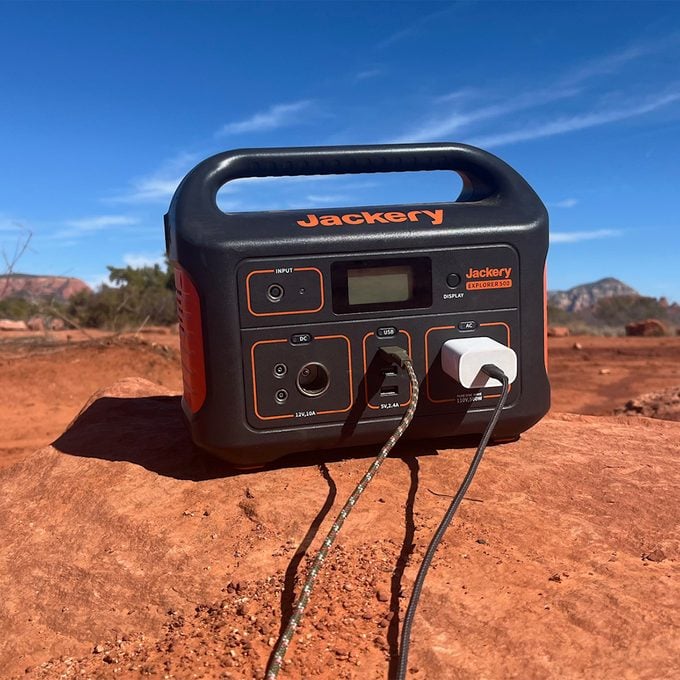
The Jackery Explorer 500 sports one 120-volt AC outlet (standard household outlet), three USB-A ports, one 12-volt DC outlet (cigarette lighter port AKA car charging port) and two 6-millimeter DC outlets. This range of ports allows you to charge multiple devices in the Jackery simultaneously. As I write this, the Jackery is charging my laptop in the AC outlet, my iPhone in one of the USB-A ports and my Bluetooth earbuds in another USB-A port.
I do wish the Jackery 500 had a second 120-volt AC outlet because I have a few devices that don’t disconnect from their charging block (like iPhone chargers do) and require the AC outlet. If more than one AC device needs to charge, they have to take turns.
Pass-Through Charging
Pass-through charging allows you to charge a device or multiple devices while the power station itself is charging. So, I can plug my laptop into the Jackery and plug the Jackery into a 12-volt outlet in my van, and charge both while driving.
Three Ways to Recharge
When the Jackery needs charging, you have three options: plug it into an AC outlet; plug it into a 12-volt DC outlet; or use a compatible Jackery solar panel to charge it.
I always use the 12-volt option in my van and charge the Jackery while driving. The AC option requires a two-part charger, as the Jackery doesn’t directly support AC charging. Both the 12-volt cord and two-piece AC cord are included in the purchase of a Jackery Explorer 500.
A note about charging times: According to the product specifications on the Jackery website, it takes 7.5 hours to get a full charge from 0% when using the AC or DC cord and 9.5 hours when using a solar panel connection.
Frankly, those charge times are outrageous in today’s world. Other similar power stations boast recharge times of less than three hours for all charging options, so I’d like to see Jackery get up to par with future iterations of the Explorer 500.
That said, I never realized the unit took so long to recharge until I read those specs. After using the Jackery for two years, I have yet to be frustrated with the charge time. I may have just never noticed since I charge the unit while I’m driving. But this is something to consider in your product search.
Battery Management System Protection
The Jackery’s BMS (battery management system), pure sine wave inverter and temperature sensors protect against short circuits, overcharge, overvoltages and freezing or overheating.
Large Working Temperature Range
The Jackery Explorer 500 is capable of both inputting charges and outputting charges in a temperature range of 14 degrees to 104 degrees. This is not the broadest working temperature range across portable power stations today, but I believe it covers all of the bases for most people.
Backlit LCD
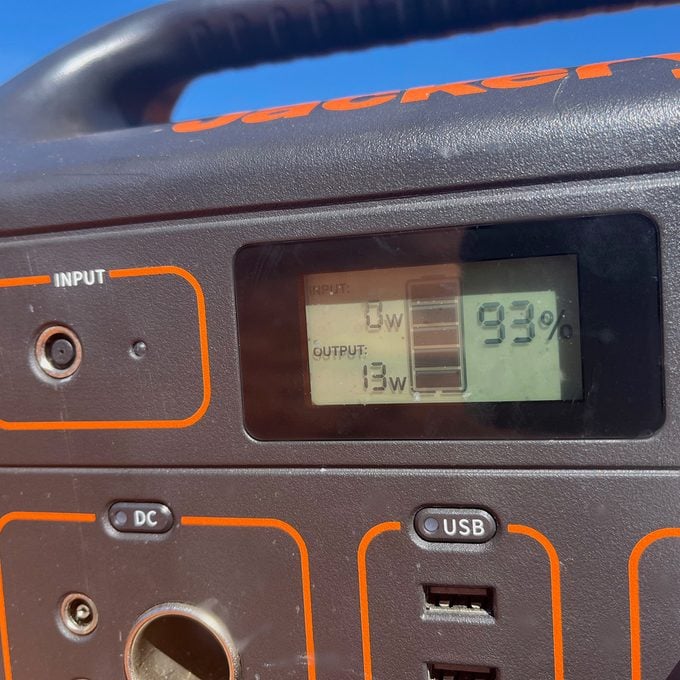
The simple backlit LCD allows you to see the current charge status of your Jackery, as well as current input and output.
Flashlight and Easy-Carry Handle
The Jackery generator is easy to transport thanks to its light weight of about 13 pounds and the handle over the top of the unit. Additionally, the power station features a flashlight, which is handy if you’re using the unit at night or transporting it to a hike-in campsite.
How We Tested the Jackery Generator
This is less of an “I tried it” situation and more of an “I use this every day of my life” situation. My Jackery 500 is like a trusty, reliable friend at this point. I know I can count on it to do what I need it to do: extend the life of my van’s battery by taking some of the strain.
I use the Jackery primarily for charging small-to-medium electronics: my cell phone, my dog’s e-collar, my laptop, DSLR battery, Bluetooth earbuds, my GPS watch and the tiny portable charger I bring with me on outdoor adventures to keep my phone charged.
Though all of these items are small and require relatively small amounts of power to charge, recharging them over and over again over a few days amounts to quite a lot of juice. And, the less juice I take from my van’s battery, the longer I can run essentials like the heater, fridge, fan and water pump—resulting in the capability to stay off-grid for longer periods.
Depending on how many devices I’m charging and how frequently, the Jackery 500 generator lasts a few days up to a week from a full charge. If I don’t use it at all, the charge remains at 100% until I do—that’s one of my favorite things about this generator. It doesn’t lose its charge when it’s dormant.
Charging the Jackery
To recharge the Jackery, I plug it into a 12-volt outlet in my van while driving. When the engine is running, both the Jackery and the integrated 320-Ah battery charge up, and by the time I reach my next destination, both are revived.
The Jackery can also be recharged via a 120-volt outlet or with a Jackery solar panel. I own the 220-watt Jackery solar panel but didn’t bring it in my van for the sake of space. I’m beginning to regret that decision, as I realize how nice it would be to set up the generator and solar panel outside while at camp and enjoy an even greater charging capability from the generator without having to use the van to recharge it.
As it stands, if the Jackery generator dies while I’m posted up at camp, I put it away and switch to the integrated van outlets to charge my devices.
Pros
- 518Wh Capacity, 500W Inverter (1000W Surge)
- Simple to learn to use
- Easy-carry handle
- 3 ways to charge it: 120-volt, 12-volt, or solar
- 3 USB-A ports
- 12-volt DC outlet
- 120-volt AC outlet
- Two 10A DC outlets
- Capable of charging multiple devices at once
- Recharges while driving if plugged into 12-volt outlet
- Battery does not drain when generator is dormant
- Quiet for a generator (37.9 decibels)
- Has an integrated flashlight/lantern
- Maintains 80% charge capacity after completing 500+ full charge cycles
- Built-in protection against circuit shortages, surges, overcharge, and over-voltages
Cons
- Only one 120-volt AC outlet
- Relatively small, but still a bit bulky for van living
- No USB-C port
- Takes almost 10 hours to fully charge via solar (in complete, full sun)
- Warranty is on the shorter side
FAQ
Is it OK to leave Jackery plugged in all the time?
Information around this is conflicting. Traditional advice is to unplug your devices when they are fully charged to prevent overcharging and damage to the battery. On the brand’s website, Jackery confirms that their products are equipped with overcharge protection, but still encourages customers to unplug the generators once they reach a full charge. However, in the Explorer 1000 Power Station owner’s manual, there is an explicit answer that says unplugging the generator is not necessary. To stay on the safe side, it’s best to unplug the power station once it reaches a full charge. As mentioned earlier, I have had no issues with my Jackery 500 losing any of its charge when it sits, even for weeks, unused.
Do Jackery solar panels work on cloudy days?
Yes, Jackery solar panels (and other solar panels) work on cloudy days and in the winter. However, the output is far less than it is on a full-sun day in the summer. Expect your Jackery generator to charge more slowly on cloudy days or on days when the UV index is low.
Can you leave Jackery solar panels in the rain?
It depends on the exact solar panel model you have. The Jackery SolarSaga 60W and SolarSaga 100W are not waterproof and should not be left outside in the rain. The Jackery SolarSaga 200W, 300W and 80W are rated IP67/IP68, meaning they are technically dust and weather-resistant, but Jackery still doesn’t recommend leaving them out in the rain. Plus, the power stations are not waterproof, so there’s no point in leaving your solar panels out, anyway.
What Other Reviewers Had to Say
With nearly 9,000 reviews on Amazon, the Jackery Explorer 500 has a 4.7-star average—not bad.
Five-star reviewer, R. Ridley, writes, “Great product. Love this and am very glad I got it…it is everything as advertised. I bought this as a backup power source for if/when we lose power. I have a CPAP and wanted to make sure the 500 could handle it, so I have tested it multiple times over this week. With only CPAP on, tube heat off, and humidity tank off, I got great power several nights.”
Verified Amazon purchaser, Troyellen, has this to say, “Had our first storm this year and while at work, my car locks froze up tight. Luckily I got a ride home. Went back the next day with my Jackery 500 and a hair dryer and had my locks thawed and opened in just a few minutes. Hate to think how much it would have cost to call a locksmith out to open my car. Amazed at how handy this product is.”
There aren’t a ton of expert reviews on the Jackery Explorer 500 from gear testers; from what I’ve read, gear experts seem to feel that it’s a solid unit, but some improvements could be made. Namely, people want to see faster charging, particularly with the solar setup. I’m in full agreement here: seven to 10 hours for a full charge verges on outrageous in today’s tech-heavy world. Another common request is an additional 120-volt AC outlet since there is only one on the current model. I would love to see both of these improvements on a future iteration of the Jackery 500.
Product Comparison
If you’re in the market for a portable generator, you’ve likely also come across other popular brands, such as Bluetti, Anker, Goal Zero, EcoFlow and BougeRV. Let’s take a look at the Jackery Explorer 500 Portable Power Station vs Goal Zero YETI 500 Portable Power Station, another similar and popular battery generator.
The Goal Zero YETI 500 Portable Power Station is the more powerful of the two, and for the same price, it’s hard to recommend the Jackery over it. To be clear, I love my Jackery 500 and I am very happy with it; I have no intention of replacing it any time soon. However, as a gear reviewer, my job is to steer you toward the best purchase possible, and in this instance, the Goal Zero generator is the better buy.
For the same price, you get:
- More than quadruple the charge cycles
- Substantially faster recharging of the power station
- More port options
- A greater working temperature range
- A longer warranty
- An IPX4 rating for water resistance
The tradeoffs are minor: The Goal Zero YETI weighs 3 pounds more than the Jackery Explorer 500 and has a watt-hour capacity of 499, 19Wh less than the Explorer’s 518Wh. Should you find the Jackery Explorer 500 on sale on Amazon, I would say go ahead and get it—you definitely won’t regret that purchase. Also, I haven’t personally tried the Goal Zero YETI 500, so I can’t speak to its performance in real life.
Final Verdict
As a consumer, I’m more than happy with the Jackery Explorer 500 Portable Power Station. I’ve had it for about two years, and it hasn’t let me down yet. My favorite features include the variety of charging ports, the built-in light, the fact that I can charge it while I drive my van and that it doesn’t lose any charge when it sits dormant for extended periods.
Although there are more powerful portable generators available at the same price point, I do not think the Jackery 500 is a bad purchase, and I do think most people will be happy with it.
Where to Buy the Jackery Portable Generator
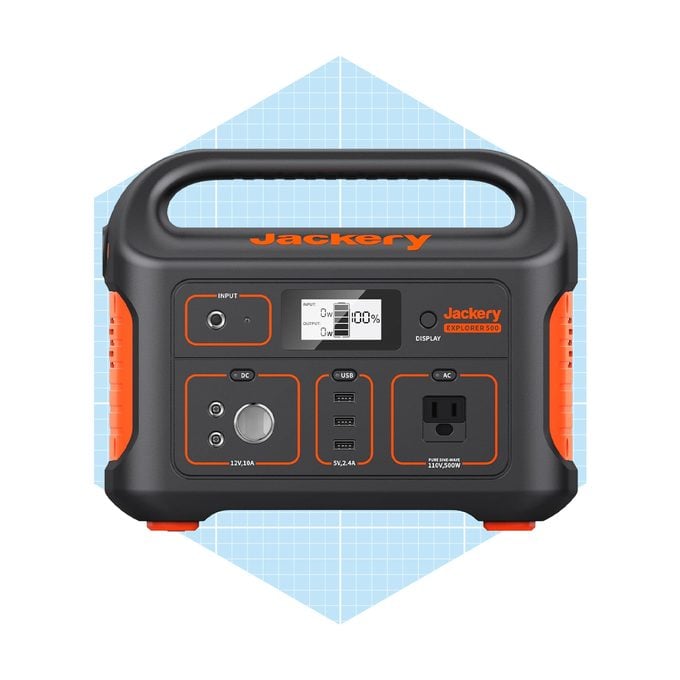 VIA MERCHANT
VIA MERCHANT
We Tried It
Jackery Explorer 500
The Explorer 500 portable power station is built with the lithium-ion battery pack, in a safely designed frame structure to maximize power for outdoor adventures and home use.
You can buy the Jackery Explorer 500 directly from the Jackery website and on Walmart for a list price of $499. Plus, it’s available on Amazon, where it is frequently on sale at a lower price.
